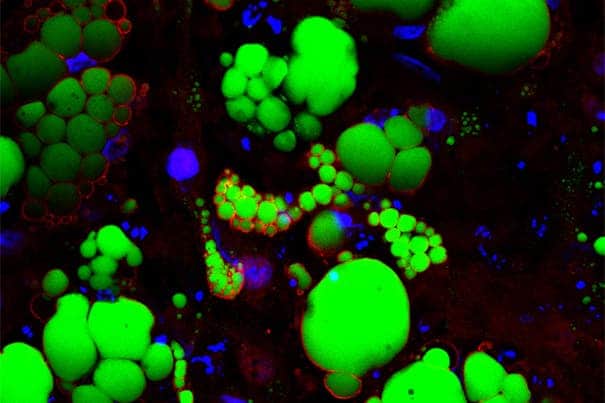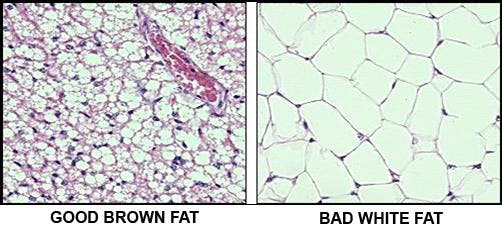Harvard Stem Cell Institute (HSCI) researchers have taken what they describe as “the first step toward a pill that can replace the treadmill” for the control of obesity – they have developed a pill which can turn white (bad) fat into brown (good) fat.

Personally, I’m not a believer in a magic cure for qetting rid of those extra pounds. No matter how you look at it, fighting obesity is a process which requires significant of effort, both in terms of physical exercise and dieting and there’s no silver bullet. But any help is more than welcome. HSCI principal faculty member Chad Cowan and his team members at Harvard University and Massachusetts General Hospital (MGH), a Harvard affiliate believe they have found just that – they have identified compounds that have the potential to turn white, or “bad,” fat cells into brown, or “good,” fat cells. They believe the compounds can be easily synthesized in a pill.
This doesn’t mean that they’ve already developed a pill which will hit the shelves – it will take quite a while before effective and safe medication will be created based on these findings, but the first steps have been taken
White fat and Brown fat
There are two types of fat (or adipose tissue) in humans – white fat and brown fat. In healthy, non-overweight humans, white adipose tissue composes as much as 20% of the body weight in men and 25% of the body weight in women. However, in overweight and obese people, it amounts for a much higher percentage, and this is a big problem. White fat is considered “bad fat” because it can cause numerous health problems; you get it by consuming too many and eliminating too few calories – basically, it’s the body’s way of storing the extra energy you geet from food.
Brown fat on the other hand is considered “good fat” – you get it by exercising, which can convert white fat to a more metabolically active brown fat and sleeping properly. Basically, the purpose of brown fat is to burn calories in order to generate heat. This is why it’s considered “good fat” – because it helps us burn, and not store calories.

Cowan’s group has found two small molecules that convert fat stem cells, which normally would produce white fat, into brown-like fat cells. Of course, this couldn’t replace exercising, because exercising provides much more benefits than burning fats, but it may provide complementary aid. The report by Cowan, an associate professor in Harvard’s Department of Stem Cell and Regenerative Biology, and colleagues was released online earlier today by the journal Nature Cell Biology. Cowan said:
“We were really impressed by is that there are some compounds that have this same kind of effect when they are administered to animals, but when you remove them, the effect goes away. But what we saw here was a stable conversion of white fat cells to brown cells.”
“You’re constantly replenishing your fat tissue,” Cowan explained, “so if you were on a medication to convert the cells, each new fat cell would be more metabolically active and would convert to brown fat over time,” reducing the likelihood of developing type 2 diabetes or any of the other conditions related to a buildup of fat.
In other words, there would be numerous benefits for a pill with these compounds, but it wouldn’t be a wonder pill to help you lose weight.
Still a long way to go
There are also potential health hazards associated with this approach which have to be dealt with before we can discuss a product hitting the shelves.
“[The compounds] target the same molecule, and that molecule plays a role in the inflammatory response. So if you administered them for a long time, the person taking them could become immune-compromised,” so it’s pretty clear that the compounds have to be modified to keep only their positive effects, and eliminate the negative side effects.
However, there is much potential for this type of research. The team made their study in collaboration with drug giant Roche Pharmaceuticals, Cowan said, but “unfortunately, the collaboration with Roche has ended because the company decided, for unrelated reasons, to end its metabolic disease program.” However, after these promising results I’m pretty sure other companies will be eager to pick up where Roche left off.
“We found these two compounds by screening a library of about 1,000 compounds,” Cowan said, “so we know that if we have access to the typical pharmaceutical company library of 1.5 to 2 million compounds, we will find others.” Cowan is currently in discussion with several pharmaceutical companies about continuing the work. Additionally, a collaborator in Germany has been testing the first two compounds on mice. “We expect to have results fairly soon,” Cowan said, adding that, “The compounds appear to work the same way in mice, but we don’t know what the long-term metabolic or immune system effects are.
Journal Reference:
- Annie Moisan, Youn-Kyoung Lee, Jitao David Zhang, Carolyn S. Hudak, Claas A. Meyer, Michael Prummer, Sannah Zoffmann, Hoa Hue Truong, Martin Ebeling, Anna Kiialainen, Régine Gérard, Fang Xia, Robert T. Schinzel, Kurt E. Amrein and Chad A. Cowan. White-to-brown metabolic conversion of human adipocytes by JAK inhibition. Nature Cell Biology, December 2014






